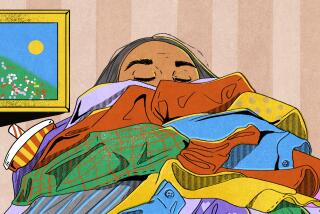Possession Obsession
- Share via
Mostly, it’s pictures of stuff: 20 pairs of shoes, two cellos, a samovar and a bag of rice. But look closer. It’s the stuff of which lives are made.
The exhibition, “Material World: A Global Family Portrait,” is pictures of families from around the world, surrounded by their most prized possessions. Organized around the question, “Can all 5 billion of us have all the things we want?,” the show highlights the dispersal and disparity of wealth in the world, but also how people make meaning of their lives.
Photographer Peter Menzel conceived of the traveling show, now at the Fullerton Museum Center, in 1994. With the help of data experts at the United Nations and World Bank, he selected 30 families, deemed “statistically average” for their countries.
After the selection, Menzel and 15 other photographers each spent a week with a family, culminating with a formal portrait of the family, their home and belongings.
The pictures in the exhibit are displayed with brief, explanatory panels, listing family members, their possessions and where they live. The photos are grouped according to geographical region, emphasizing the economic disparity even within regions.
The Nguyen family in Vietnam, for example, is displayed next to the Japanese Ukita family. The Nguyens’ most technologically advanced possessions are a couple of bikes--one Vietnamese, one Czech. The Ukita family owns, among a host of other things, an electric piano, video games, a color TV, and lots of high-tech kitchen appliances.
These two portraits highlight fundamental differences in everyday lives: The Ukita family has leisure time, as evidenced by the video games and electronic toys; the Nguyen family has no such luxuries, all possessions are utilitarian.
In Mongolia, it’s a little of both. A picture of the Regzen family in their Ger (a circular tent) shows how these nomads value utility and those objects which are strictly entertaining or decorative. Among their favorite possessions are two china cabinets (including several tea sets and figurines) as well as a goat. And the children own Rangers cartoon merchandise.
Charles C. Mann writes in an essay about the exhibition: “Most immediately apparent is the stream of corporate capitalism that now washes over the globe, inundating everyone from Mali to Malibu in boom boxes, baseball caps, and Batman movies. . . . As human consumption patterns look more and more alike, the marching billions all with their cheeseburgers and Levi 501s, that unique place becomes ever harder to find.”
*
But the photographers did not set out to find that unique place. As Menzel writes in the book for the exhibit, the photographers rather wanted to show a cross-section of the world, with special emphasis on fast-growing Pacific Rim economies and countries in the news.
One place on the news in 1994 was Bosnia. And the portrait of the Demirovic-Bucalovic family in Sarajevo from that year is unique in its depiction how people seek to establish a semblance of normality under extremely hostile circumstances.
The baby carriage, for example, is now used to transport bottles of water. The mattress, no longer a resting place but a sniper barricade for the living room. Two U.N. soldiers stand nearby, protecting the family. As the explanatory panel dryly notes in parentheses, they are “not part of household.”)
Despite the obvious differences in material wealth and circumstances, the pictures’ thematic organization emphasizes our similarities--how our lives are organized around certain essential elements: family, a place to live, some material possessions.
And, for some, faith.
The Skeen family of Texas and the Namgay family in Bhutan are portrayed with religious texts and artifacts in front of them.
And those two portraits typify the humanistic point of the exhibit: We may own different stuff, but we’re made of the same material.
*
“Material World--A Global Family Portrait,” Fullerton Museum Center, 301 N. Pomona Ave. Hours: Wednesday, Friday, Saturday and Sunday, noon-4 p.m.; Thursday, noon-8 p.m. Through Aug. 13. Admission: $3; $2 students. Admission is $1 Thursdays, 6-8 p.m. Closed Mondays and Tuesdays. Information: (714) 738 6545.
More to Read
The biggest entertainment stories
Get our big stories about Hollywood, film, television, music, arts, culture and more right in your inbox as soon as they publish.
You may occasionally receive promotional content from the Los Angeles Times.










